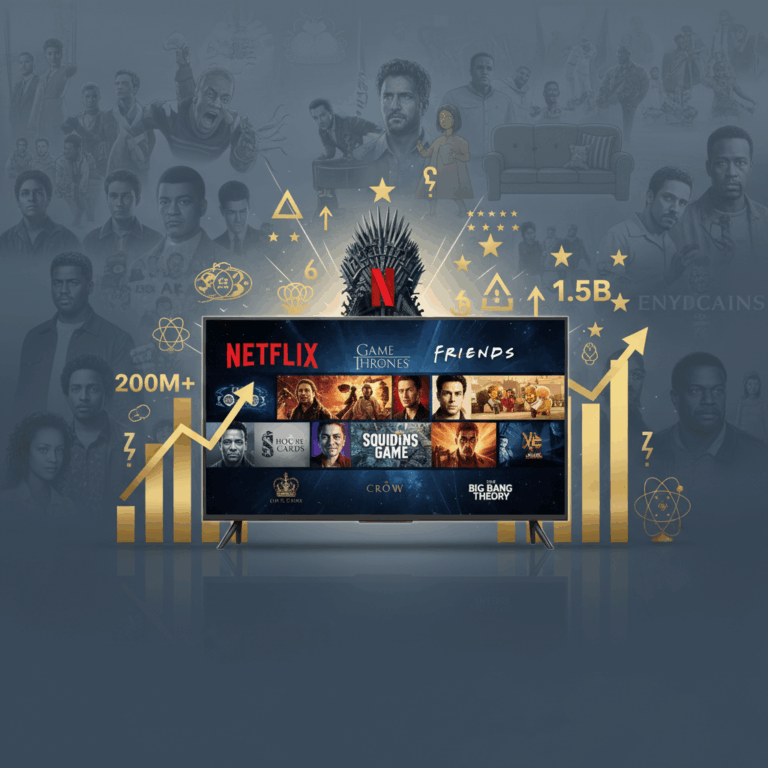Record-breaking audiences for TV series
Television series have managed to break audience records throughout time, marking unforgettable moments in the history of world entertainment.
From the era of broadcast television to the rise of streaming, certain programs have stood out for capturing the attention of millions and leaving a cultural mark.
These milestones reflect both the power of storytelling and the evolution of media and the consumption of audiovisual content.
M*A*S*H: the absolute record on broadcast television
M*A*S*H holds the unbeatable record for viewership on broadcast television; its finale in 1983 was watched by 105.9 million viewers in the United States alone.
This episode achieved an impressive 60% from American households, a figure that no other series has managed to match to this day, cementing its place in history.
The reach and popularity of M*A*S*H exemplify the heyday of mass television before the emergence of new platforms.
The cultural impact of Game of Thrones in the modern era
Game of Thrones revolutionized modern television, reaching over 19 million viewers on official platforms and exceeding 30 million per episode.
The series not only dominated in audiences, but also won 59 Emmy Awards, the highest recognition for a television production.
Its cultural influence was global, sparking debates and generating communities of followers during its eight seasons on air.
Featured series by genre and awards
Television series stand out not only for their audience, but also for the genre and the awards they have won over time.
Comedies, dramas, and awards like the Emmys determine the impact and quality of these productions in history.
This recognition underscores the cultural and nostalgic relevance of the series that marked different television eras.
Iconic comedies: Friends and its dominance in the 90s
Friends was the most watched comedy during the 90s, with more than 30 million viewers per week and six consecutive years as the leading sitcom.
The series stood out for its endearing characters and accessible humor, becoming a benchmark of the genre that still retains global popularity.
Its success reflected the public's preference for light formats and everyday situations that connected with diverse audiences.
Influential dramas: The Sopranos and Breaking Bad
The Sopranos ushered in the "Golden Age of Television" with peaks of 11 million viewers and won 21 Emmy Awards, marking a turning point in dramas.
Breaking Bad started with modest audiences but grew to 10 million by its finale, receiving critical acclaim and Guinness World Records.
Both series redefined television drama with complex plots and deep characters, influencing later generations.
Emmy Awards and Recognitions
The Emmys are the highest recognition in television and have awarded series that set trends and achieved excellence in production and acting.
Freedom and The Sopranos stand out with numerous awards, reflecting the quality and critical and public acceptance in their respective decades.
These awards help perpetuate the legacy of the most influential series and attract new audiences to these iconic productions.
Streaming phenomena and their influence
Streaming has revolutionized the way we consume series, allowing global productions to reach unprecedented audiences.
This change boosted the emergence of cultural phenomena, which generate historical records on platforms like Netflix and others.
Streaming series are setting new ways of measuring popularity, based on hours viewed and digital accessibility worldwide.
The Squid Game and other hits on Netflix
The Squid Game became Netflix's biggest phenomenon, accumulating 1.65 billion hours viewed in its first 28 days, an unprecedented figure on the platform.
This success demonstrates streaming's ability to globalize content, impacting audiences that were previously unreachable by traditional television.
Other series such as Stranger Things and Wednesday also set records and consolidated Netflix as a benchmark in digital entertainment.
Stranger Things and Wednesday: record viewing hours
Stranger Things, with its fourth season, reached 1.352 billion hours viewed in one month, underlining its great global appeal.
Wednesday also set new digital audience records, reflecting how the combination of nostalgia and new characters attracts massive views.
Both series demonstrate the importance of streaming in maintaining the relevance of franchises and exploring new, captivating narratives.
Key audiences by region
Television audiences vary considerably by region, reflecting different cultures and habits that influence the popularity of series.
Some productions have achieved massive success in certain territories, becoming cultural symbols that transcend generations.
These regional phenomena show how television connects with local identities and remains relevant over time.
Popularity in Latin America: El Chavo del 8
El Chavo del 8 reached a daily audience of more than 350 million in Latin America, establishing itself as an iconic series in the region.
Its simple humor and endearing characters managed to connect with different generations, becoming a benchmark of Hispanic popular culture.
The series is still airing and is recognized for its ability to unite families and communities through its accessible and universal content.
Asian series and longevity: Detective Conan
Detective Conan is an Asian phenomenon that has surpassed 1,000 episodes, standing out for its longevity and loyal fanbase worldwide.
Its success lies in the combination of mystery, charismatic characters, and clever plots that maintain audience interest for decades.
This series illustrates how Asian productions have gained ground and international recognition, adapting to new generations.






